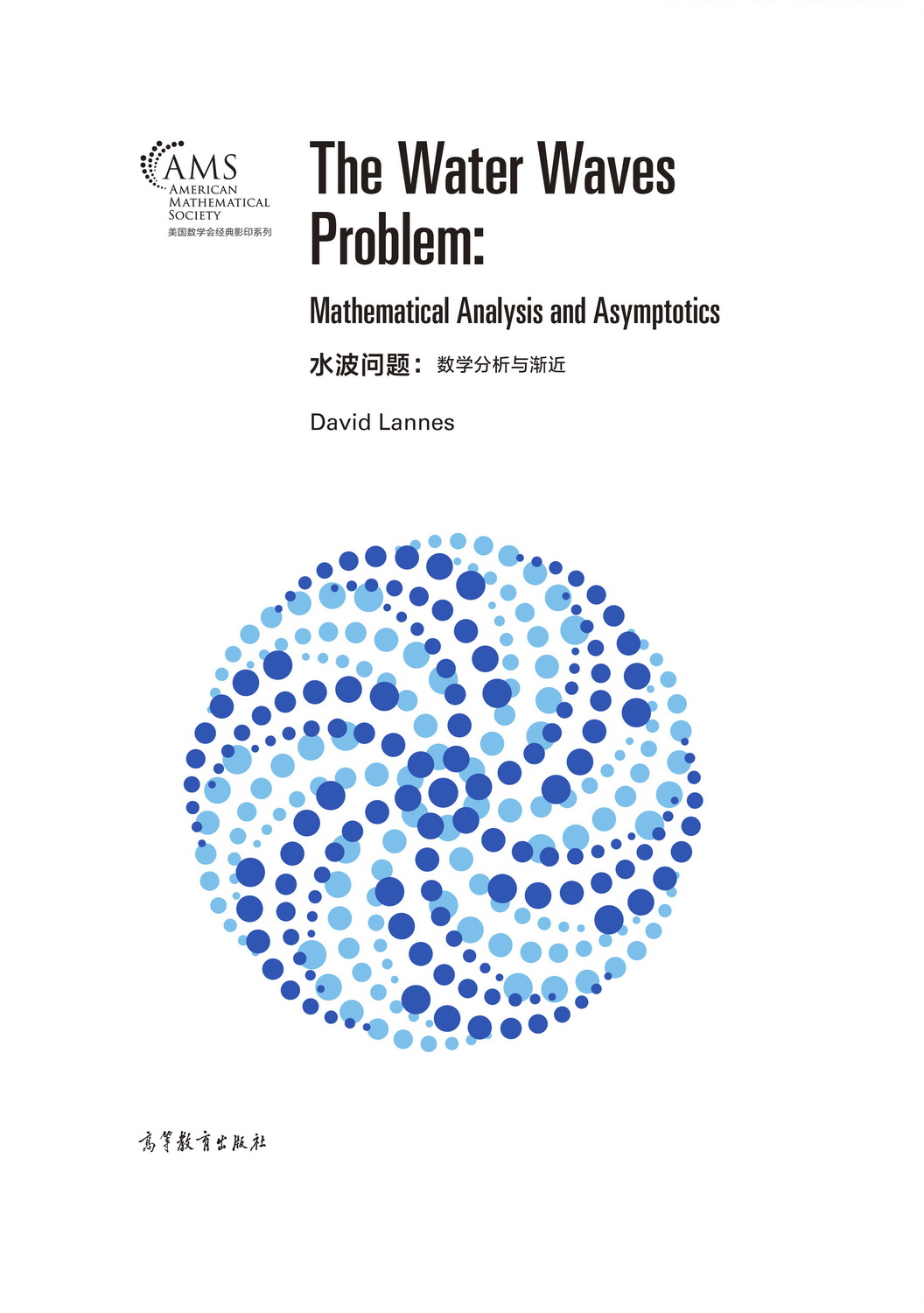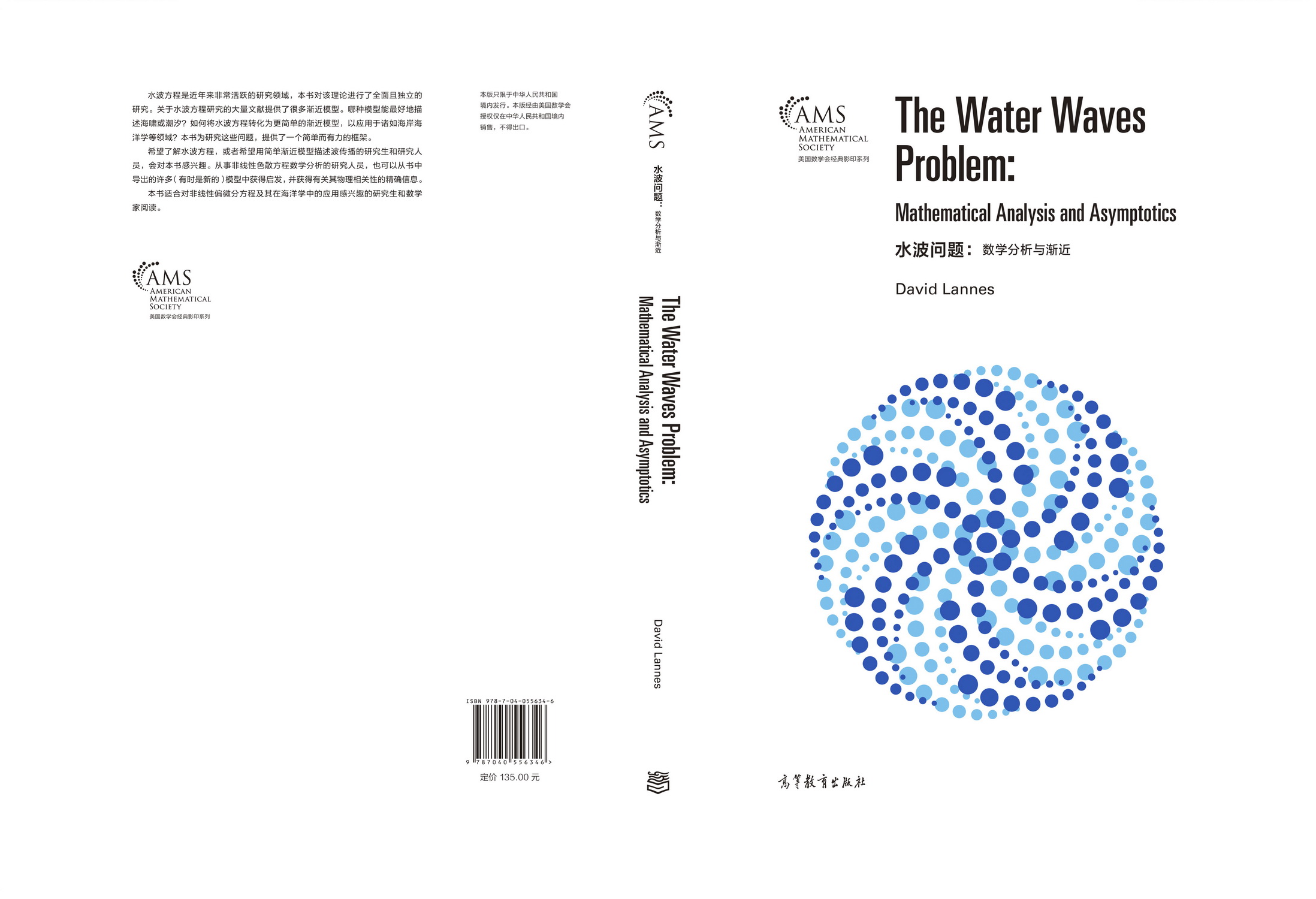水波问题:数学分析与渐近(影印版)
作者: David Lannes
出版时间:2021-03
出版社:高等教育出版社
- 高等教育出版社
- 9787040556346
- 1版
- 369853
- 48265785-5
- 精装
- 16开
- 2021-03
- 563
- 352
- 理学
- 数学类
- 数学类
- 研究生及以上
前辅文
Chapter 1. The Water Waves Problem and Its Asymptotic Regimes
1.1. Mathematical formulation
1.1.1. Basic assumptions
1.1.2. The free surface Euler equations
1.1.3. The free surface Bernoulli equations
1.1.4. The Zakharov/Craig-Sulem formulation
1.2. Other formulations of the water waves problem
1.2.1. Lagrangian parametrizations of the free surface
1.2.1.1. Nalimov's formulation in dimension d = 1
1.2.1.2. Wu's formulation
1.2.2. Other interface parametrizations and extension to two-fluids interfaces
1.2.3. Variational formulations
1.2.3.1. The geometric approach
1.2.3.2. Luke's variational formulation
1.2.4. Free surface Euler equations in Lagrangian formulation
1.3. The nondimensionalized equations
1.3.1. Dimensionless parameters
1.3.2. Linear wave theory
1.3.3. Nondimensionalization of the variables and unknowns
1.3.4. Nondimensionalization of the equations
1.4. Plane waves, waves packets, and modulation equations
1.5. Asymptotic regimes
1.6. Extension to moving bottoms
1.7. Extension to rough bottoms
1.7.1. Nonsmooth topographies
1.7.2. Rapidly varying topographies
1.8. Supplementary remarks
1.8.1. Discussion on the basic assumptions
1.8.2. Related frameworks
Chapter 2. The Laplace Equation
2.1. The Laplace equation in the fluid domain
2.1.1. The equation
2.1.2. Functional setting and variational solutions
2.1.3. Existence and uniqueness of a variational solution
2.2. The transformed Laplace equation
2.2.1. Notations and new functional spaces
2.2.2. Choice of a diffeomorphism
2.2.3. Transformed equation
2.2.4. Variational solutions for data in ˙H 1/2(Rd)
2.3. Regularity estimates
2.4. Strong solutions to the Laplace equation
2.5. Supplementary remarks
2.5.1. Choice of the diffeomorphism
2.5.2. Nonasymptotically flat bottom and surface parametrizations
2.5.3. Rough bottoms
2.5.4. Infinite depth
2.5.5. Nonhomogeneous Neumann conditions at the bottom
2.5.6. Analyticity
Chapter 3. The Dirichlet-Neumann Operator
3.1. Definition and basic properties
3.1.1. Definition
3.1.2. Basic properties
3.2. Higher order estimates
3.3. Shape derivatives
3.4. Commutator estimates
3.5. The Dirichlet-Neumann operator and the vertically averaged velocity
3.6. Asymptotic expansions
3.6.1. Asymptotic expansion in shallow-water (μ ≪ 1)
3.6.2. Asymptotic expansion for small amplitude waves (ε ≪ 1)
3.7. Supplementary remarks
3.7.1. Nonasymptotically flat bottom and surface parametrizations
3.7.2. Rough bottoms
3.7.3. Infinite depth
3.7.4. Small amplitude expansions for nonflat bottoms
3.7.5. Self-adjointness
3.7.6. Invertibility
3.7.7. Symbolic analysis
3.7.8. The Neumann-Neumann, Dirichlet-Dirichlet, and Neumann-Dirichlet operators
Chapter 4. Well-posedness of the Water Waves Equations
4.1. Linearization around the rest state and energy norm
4.2. Quasilinearization of the water waves equations
4.2.1. Notations and preliminary results
4.2.2. A linearization formula
4.2.3. The quasilinear system
4.3. Main results
4.3.1. Initial condition
4.3.2. Statement of the theorems
4.3.3. Asymptotic regimes
4.3.4. Proof of Theorems 4.16 and 4.18
4.3.4.1. The mollified quasilinear system
4.3.4.2. Symmetrizer and energy
4.3.4.3. Energy estimates
4.3.4.4. Construction of a solution
4.3.4.5. Uniqueness and stability
4.3.5. The Rayleigh-Taylor criterion
4.3.5.1. Reformulation of the equations
4.3.5.2. Comments on the Rayleigh-Taylor criterion (4.56)
4.4. Supplementary remarks
4.4.1. Nonasymptotically flat bottom and surface parametrizations
4.4.2. Rough bottoms
4.4.3. Very deep water (μ ≫ 1) and infinite depth
4.4.4. Global well-posedness
4.4.5. Low regularity
Chapter 5. Shallow Water Asymptotics: Systems. Part 1: Derivation
5.1. Derivation of shallow water models (μ ≪ 1)
5.1.1. Large amplitude models (μ ≪ 1 and ε = O(1), β = O(1))
5.1.1.1. The Nonlinear Shallow Water (NSW) equations
5.1.1.2. The Green-Naghdi (GN) equations
5.1.2. Medium amplitude models (μ ≪ 1 and ε = O(μ))
5.1.2.1. Large amplitude topography variations: β = O(1)
5.1.2.2. Medium amplitude topography variations: β = O(μ)
5.1.2.3. Small amplitude topography variations: β = O(μ)
5.1.3. Small amplitude models (μ ≪ 1 and ε = O(μ))
5.1.3.1. Large amplitude topography variations: β = O(1)
5.1.3.2. Small amplitude topography variations: β = O(μ)
5.2. Improving the frequency dispersion of shallow water models
5.2.1. Boussinesq equations with improved frequency dispersion
5.2.1.1. A first family of Boussinesq-Peregrine systems with improved frequency dispersion
5.2.1.2. A second family of Boussinesq-Peregrine systems with improved frequency dispersion
5.2.1.3. Simplifications for the case of flat or almost flat bottoms
5.2.2. Green-Naghdi equations with improved frequency dispersion
5.2.2.1. A first family of Green-Naghdi equations with improved frequency dispersion
5.2.2.2. A second family of Green-Naghdi equations with improved frequency dispersion
5.2.3. The physical relevance of improving the frequency dispersion
5.3. Improving the mathematical properties of shallow water models
5.4. Moving bottoms
5.4.1. The Nonlinear Shallow Water equations with moving bottom
5.4.2. The Green-Naghdi equations with moving bottom
5.4.3. A Boussinesq system with moving bottom.
5.5. Reconstruction of the surface elevation from pressure measurements
5.5.1. Hydrostatic reconstruction
5.5.2. Nonhydrostatic, weakly nonlinear reconstruction
5.6. Supplementary remarks
5.6.1. Technical results
5.6.1.1. Invertibility properties of hb(I + μTb)
5.6.1.2. Invertibility properties of h(I + μT)
5.6.2. Remarks on the “velocity” unknown used in asymptotic models
5.6.2.1. Relationship between the averaged velocity V and the velocity at an arbitrary elevation
5.6.2.2. Relationship between Vθ,δ and the velocity at an arbitrary elevation
5.6.2.3. Recovery of the vertical velocity from ζ and V
5.6.3. Formulation in (h, hV) variables of shallow water models
5.6.3.1. The Nonlinear Shallow Water equations
5.6.3.2. The Green-Naghdi equations
5.6.4. Equations with dimensions
5.6.5. The lake and great lake equations
5.6.5.1. The lake equations
5.6.5.2. The great lake equations
5.6.6. Bottom friction
Chapter 6. Shallow Water Asymptotics: Systems. Part 2: Justification
6.1. Mathematical analysis of some shallow water models
6.1.1. The Nonlinear Shallow Water equations
6.1.2. The Green-Naghdi equations
6.1.3. The Fully Symmetric Boussinesq systems
6.2. Full justification (convergence) of shallow water models
6.2.1. Full justification of the Nonlinear Shallow Water equations
6.2.2. Full justification of the Green-Naghdi equations
6.2.3. Full justification of the Fully Symmetric Boussinesq equations
6.2.4. (Almost) full justification of other shallow water systems
6.3. Supplementary remarks
6.3.1. Energy conservation
6.3.1.1. Nonlinear Shallow Water equations
6.3.1.2. Boussinesq systems
6.3.1.3. Green-Naghdi equations
6.3.2. Hamiltonian structure
Chapter 7. Shallow Water Asymptotics: Scalar Equations
7.1. The splitting into unidirectional waves in one dimension
7.1.1. The Korteweg-de Vries equation
7.1.2. Statement of the main result
7.1.3. BKW expansion
7.1.4. Consistency of the approximate solution and secular growth
7.1.5. Proof of Theorem 7.1 and Corollary 7.2
7.1.6. An improvement
7.2. The splitting into unidirectional waves: The weakly transverse case
7.2.1. Statement of the main result
7.2.2. BKW expansion
7.2.3. Consistency of the approximate solution and secular growth
7.2.4. Proof of Theorem 7.16
7.3. A direct study of unidirectional waves in one dimension
7.3.1. The Camassa-Holm regime
7.3.1.1. Approximations based on the velocity
7.3.1.2. Equations on the surface elevation
7.3.1.3. Proof of Theorem 7.24
7.3.1.4. The Camassa-Holm and Degasperis-Procesi equations
7.3.2. The long-wave regime and the KdV and BBM equations
7.3.3. The fully nonlinear regime
7.4. Supplementary remarks
7.4.1. Historical remarks on the KDV equation
7.4.2. Large time well-posedness of (7.47) and (7.51)
7.4.3. The case of nonflat bottoms
7.4.3.1. Generalization of the KdV equation for nonflat bottoms
7.4.3.2. Generalization of the CH/DP equations for nonflat bottoms
7.4.4. Wave breaking
7.4.5. Full dispersion versions of the scalar shallow water approximations
7.4.5.1. One dimensional models
7.4.5.2. The weakly transverse case
Chapter 8. Deep Water Models and Modulation Equations
8.1. A deep water (or full-dispersion) model
8.1.1. Derivation
8.1.2. Consistency of the deep water (or full-dispersion) model
8.1.3. Almost full justification of the asymptotics
8.1.4. The case of infinite depth
8.2. Modulation equations in finite depth
8.2.1. Defining the ansatz
8.2.2. Small amplitude expansion of (8.11)
8.2.3. Determination of the ansatz
8.2.4. The “full-dispersion” Benney-Roskes model
8.2.5. The “standard” Benney-Roskes model
8.2.6. The Davey-Stewartson model (dimension d = 2)
8.2.7. The nonlinear Schr¨odinger equation (dimension d = 1)
8.3. Modulation equations in infinite depth
8.3.1. The ansatz
8.3.2. The nonlinear Schr¨odinger equation (dimension d = 1 or 2)
8.4. Justification of the modulation equations
8.5. Supplementary remarks
8.5.1. Benjamin-Feir instability of periodic wave-trains
8.5.2. Full-dispersion Davey-Stewartson and Schr¨odinger equations
8.5.3. The nonlinear Schr¨odinger approximation with improved dispersion
8.5.4. Higher order approximation: The Dysthe equation
8.5.5. The NLS approximation in the neighborhood of |K|H0 = 1.363
8.5.6. Modulation equations for capillary gravity waves
Chapter 9. Water Waves with Surface Tension
9.1. Well-posedness of the water waves equations with surface tension
9.1.1. The equations
9.1.2. Physical relevance
9.1.3. Linearization around the rest state and energy norm
9.1.4. A linearization formula
9.1.5. The quasilinear system
9.1.6. Initial condition
9.1.7. Well-posedness of the water waves equations with surface tension
9.2. Shallow water models (systems) with surface tension
9.2.1. Large amplitude models
9.2.2. Small amplitude models
9.3. Asymptotic models: Scalar equations
9.3.1. Capillary effects and the KdV approximation
9.3.2. The Kawahara approximation
9.3.3. Capillary effects and the KP approximation
9.3.4. The weakly transverse Kawahara approximation
9.4. Asymptotic models: Deep and infinite water
9.5. Modulation equations
Appendix A. More on the Dirichlet-Neumann Operator
A.1. Shape analyticity of the Dirichlet-Neumann operator
A.1.1. Shape analyticity of the velocity potential
A.1.2. Shape analyticity of the Dirichlet-Neumann operator
A.1.2.1. The case of finite depth
A.1.2.2. The case of infinite depth
A.2. Self-Adjointness of the Dirichlet-Neumann operator
A.3. Invertibility of the Dirichlet-Neumann operator
A.4. Remarks on the symbolic analysis of the Dirichlet-Neumann operator
A.5. Related operators
A.5.1. The Laplace equation with nonhomogeneous Neumann condition at the bottom
A.5.2. The Neumann-Neumann, Dirichlet-Dirichlet, and Neumann-Dirichlet operators
A.5.3. A generalized shape derivative formula
A.5.4. Asymptotic expansion of the Neumann-Neumann operator
A.5.5. Asymptotic expansion of the averaged velocity
Appendix B. Product and Commutator Estimates
B.1. Product estimates
B.1.1. Product estimates for functions defined on Rd
B.1.2. Product estimates for functions defined on the flat strip S
B.2. Commutator estimates
B.2.1. Commutator estimates for functions defined in Rd
B.2.2. Commutator estimates for functions defined on S
B.3. Product and commutator with Ck functions
B.4. Product and commutator in uniformly local Sobolev spaces
B.4.1. Uniformly local Sobolev spaces
B.4.2. Product estimates
B.4.3. Commutator estimates
Appendix C. Asymptotic Models: A Reader's Digest
C.1. What is a fully justified asymptotic model?
C.2. Shallow water models
C.2.1. Low precision models
C.2.2. High precision models
C.2.3. Approximation by scalar equations
C.3. Deep water and infinite depth models
C.4. Modulation equations
C.4.1. Modulation equations in finite depth
C.4.2. Modulation equations in infinite depth
C.5. Influence of surface tension
C.5.1. On shallow water models
C.5.2. On deep water models and modulation equations
Bibliography
Index







